#Hataraki Man
Explore tagged Tumblr posts
Text
The fact that the Eyeshield 21 anime is lame is triple painful for me as: a) an Eyeshield 21 manga fan, b) a Yusuke Murata fan and c) a Yu-Gi-Oh GX fan
After all, it's very likely that the reason most of the GX episodes were outsourced to DongWoo (thus the animation being PowerPoint-y most of the time) is because Studio Gallop was pretty much focusing their best animators and resources to Eyeshield 21.
Eyeshield 21 was Gallop's last long-running shonen project before they became a studio focused primarily to Yugioh anime (from 5Ds onwards you can notice a hike in animation) and low-budget children/educational shows. Hataraki Man was a short seinen anime and Me and Robocco is probably the first ambitious project they take after Konami pretty much fired them as their Yugioh animators.
I wonder if at some point Konami was like "yeah, maybe we should have just stayed at Toei"

22 notes
·
View notes
Text
Do You Know This Anime?

11 notes
·
View notes
Text

hataraki man - moyoco anno (2004-2006)
17 notes
·
View notes
Text

MEEEEEE
2 notes
·
View notes
Text
2024 Anime Watch List
March:
This post is part of my ongoing record for the new (to me) anime I watch in 2024. I'm excited to see what new shows and films I discover as this list grows through the year.
A Sign of Affection (2024) episodes: 12 started: 2-7-24 finished: 3-30-24 rating: 9/10

The Demon Prince of Momochi House (2024) episodes: 12 started: 2-10-2024 finished: 4-8-2024 rating: 8/10

Cherry Magic! Thirty Years of Virginity Can Make You a Wizard?! (2024) episodes: 12 started: 2-17-24 finished: 3-28-24 rating: 9/10
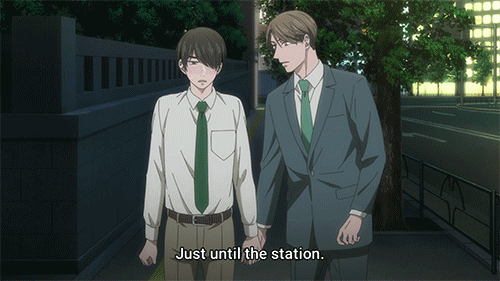
Sugar Apple Fairy Tale (2023) episodes: 24 started: 3-12-23 finished: 3-14-24 rating: 9/10

Hataraki Man (2006) episodes: 11 started: 3-18-24 finished: 3-19-24 rating: 8/10

Psychic Detective Yakumo (2010) episodes: 13 started: 3-21-24 finished: 3-22-24 rating: 7.5/10

Previous Months:
January Watch List
February Watch List
#2024 anime watch list#my anime list#march anime list#a sign of affection#the demon prince of momochi house#cherry magic#sugar apple fairy tale#hataraki man#psychic detective yakumo
3 notes
·
View notes
Text
#hataraki man#tunes#anime soundtrack#frutiger aero#anime#anime music#instrumental anime music#instrumental#fav#Spotify
0 notes
Text

Hataraki Man Vol.5
1 note
·
View note
Text
"Me and Kimono" | Interview with Atsufu
Translation of the interview with Moyoco Anno published in the June 2023 issue of "Neppū" on Note.
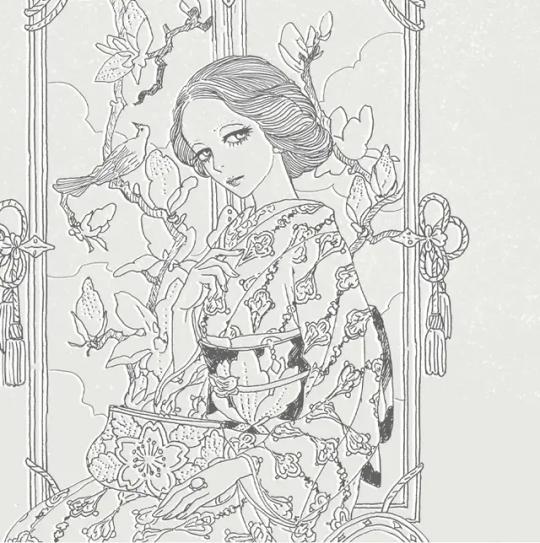
Starting from the May 2021 issue, Moyoco Anno's cover illustrations mark the beginning of the third year with this June issue. When you think of Moyoco, you might recall the image of modern, real-life women wrapped in contemporary fashion, symbolized by works like "Hataraki Man" and "Happy Mania." So, why did Moyoco choose to depict "women in kimono, with a somewhat classical vibe" on the cover? We inquired about Moyoco's affection for kimono, which underlies this decision. Nowadays, Moyoco's passion for kimono has grown to the extent of establishing her own brand that creates kimono with her unique artistic style. This "kimono fever" seems to stem from a desire to see more people casually wearing and embracing Japan's beautiful nature, such as its plants and birds, through clothing.

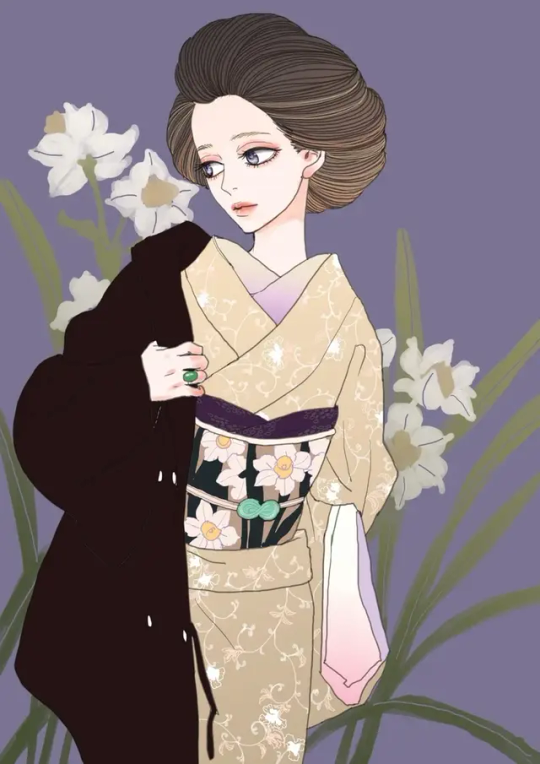

My grandfather's kimono and the kihachijo he wore at the age of 3
Interviewer: Thank you very much for illustrating the cover for the past two years since the May 2021 issue. It has been well received that 'women in kimono evoke various stories,' and we are grateful for that. As a result, we have decided to continue for another year. Producer Suzuki (Toshio) even joked, 'We would like to continue until Moyoco-san gets tired of it.'
Anno: Is that true? Isn't it just that you're getting too lazy to change (laughs)?
Interviewer: That's not true at all (laughs). I'm serious. So, I'd like to take this opportunity to ask you about your connection with kimonos, Moyoko-san, and hear a comprehensive discussion about it. When did you first become fascinated with kimonos?
Anno: My grandfather was a kimono wearer. He always wore kimonos in his daily life. Perhaps it was also because of the area, Shimokitazawa in Tokyo, but when I was a child, there were quite a few people like that in the neighborhood. If there were about ten elderly people in the neighborhood, for example, about two of them would be wearing kimonos. Among relatives, it was only my grandfather, though.
Interviewer: So it wasn't yukata, but kimonos.
Anno: They were ordinary men's kimonos. Made of sturdy fabric, they came with a haori, juban, and ensemble. He also wore a coat for kimonos in winter. When we lived together, my grandfather's way of casually taking off his kimono was impressive. Men's kimonos are designed to be worn at the same length, so the juban worn underneath can be removed together. He would hang it on a clothes rack, wearing only fundoshi and underwear, and then go to bed just like that.
Interviewer: It's like shedding a skin, isn't it?
Anno: Exactly. Then, when I woke up in the morning, I would put it back on just like that (laughs). Since kimonos aren't washed every day, men's kimonos are quite convenient, right?
Interviewer: Your grandfather was a tailor, if I recall correctly.
Anno: Yes, that's right. But he had already retired by then. However, since he loved sewing even after retirement, he was always making something, and when I was little, he made various things for me too.
Interviewer: When did you start experiencing kimonos yourself?
Anno: I was already wearing a yellow hakama ensemble when I was about three years old. I can't remember if it was a gift or someone's hand-me-down, but I wore it for New Year's and in the winter. I always used to fuss about not wanting to take it off once it was put on me.
Interviewer: Was it comfortable to wear?
Anno: I loved it. Maybe part of it was because I was happy to be with my grandpa. Also, one time when the maid who was at my grandfather's house said she was going back to her hometown, I followed along. I was delighted to be dressed in children's festival attire there. We brought back that festival attire and kept it at home.
Interviewer: So, it seems like you were quite enthusiastic about kimonos even at the age of three.
Anno: Indeed, I liked kimonos from that time. But you know, it's a hassle for parents to dress you up every time, right? When I was little and happened to have something that fit me, they would dress me up, but as I grew older, it wasn't so easy. Still, they always bought me yukatas every year. When I was in elementary school, whenever there was a Bon dance in the neighborhood, my school friends and I would all go out wearing yukatas. Once I was dressed in a yukata, I would wear it every day for about a week from then on. Like, going to the school pool in the morning during summer vacation, and then coming home and wearing a yukata around the house.
Interviewer: Didn't you ever walk around the neighborhood dressed like that?
Anno: If you walk around in a yukata when it's not a festival, you'll definitely get some strange looks (laughs).

Encountering antique kimonos
Interviewer: What was the subsequent evolution of your interest in kimonos like?
Anno: When it comes to kimonos for girls, it's usually associated with the coming-of-age ceremony, right? Well, about a week before that, I injured my foot. What's more, at that time, my family was too poor to afford to borrow a formal furisode for the coming-of-age ceremony. So, I didn't wear a kimono for the ceremony. Then, because they felt sorry for me not being able to attend the ceremony, my friends suggested we all get together wearing kimonos. They all had kimonos bought for them, so they wanted to wear them again at least once. They were all dolled up in furisode with fluffy white shawls, but I was the only one in a plain casual kimono. Mine was a cute komon with a navy background adorned with little hammers and treasures, but compared to everyone else's formal attire, it did seem a bit plain (laughs).
Interviewer: Even though your friends didn't mean any harm, it must be a bitter memory.
Anno: At that time, I realized that you really need financial stability to afford kimonos, and I distanced myself from them a bit. Buying a kimono isn't the end of it; you also need a place to store it. You definitely need a certain amount of storage space. And because the rules for storing kimonos are different from regular clothes, you need a dedicated space for them.
Interviewer: Did your enthusiasm for kimonos reignite around the time you started serializing "Sakuran," which features Kiyoha, a courtesan in Yoshiwara, around 2001?
Anno: I think it was before that… It was around my mid-20s when I was living alone in Ebisu, Tokyo. There was a pop-up antique kimono shop at an event venue, and I encountered some really beautiful kimonos there. I wore one of those kimonos for the cover of "AERA" magazine (May 5, 2003 issue). It was the first time I encountered an antique kimono that fit me perfectly in terms of length, even with my height. It was a beautiful silk kimono with a reddish-purple hue and vertical stripes with a bluish tint.
Interviewer: Did you dress yourself for the "AERA" photo shoot?
Anno: Yes, I did. Looking back now, I realize it was a mess, and I wonder how I managed to go to the shoot (laughs).
Interviewer: Why did you decide to feature kimonos in the photos?
Anno: I really didn't have anything else to wear (laughs). I wasn't making enough money to indulge myself. Although I wasn't in debt anymore, I still didn't have time to go shopping for clothes or anything like that.
Interviewer: You didn't have the mental space for it either.
Anno: Exactly. When I was working at home, I usually just wore casual clothes, so I thought about what to wear for the "AERA" cover.
Interviewer: Ah, you remembered you had kimonos.
Anno: Ironically, I had nothing but kimonos (laughs). I tend to be like that quite often. People sometimes say I'm like a fashionable manga artist, but that's not the case at all.
I remember when I was invited to a home party by fellow female manga artists at the time. I thought it was just a casual gathering at home, so I went there thinking it was fine to wear casual clothes, but everyone else was dressed head-to-toe in Chanel, Prada, or Gucci.
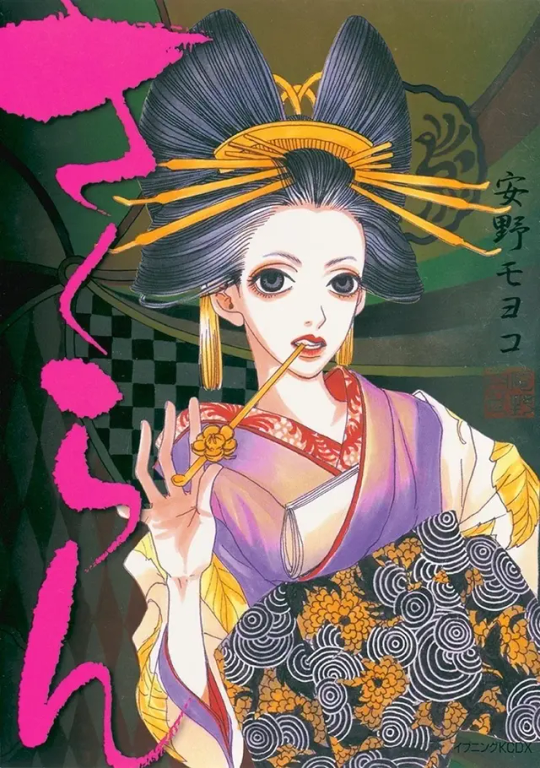
Visiting vintage clothing stores in Kamakura
Interviewer: You got married to director Hideaki Anno in 2002 and moved to Kamakura in 2004. I heard that during this time, you were already collecting kimonos by visiting nearby vintage clothing stores.
Anno: It all started when we had the chance to go to Kyoto shortly after we got married, and we met a friend of the director who was from Kyoto and was also an expert in kimono, as his wife was a Kyoto native who was also into Japanese traditional dance. So, when I casually mentioned that I was also interested in kimonos, she introduced me to a well-established kimono shop in Kyoto. Since the director was very enthusiastic about our marriage and told me to "buy whatever you want," it kind of turned into a situation like that (laughs).
Then the wife said, "You'll get the hang of it if you try wearing it once," and she dressed me up on the spot. The next day, when we were heading back to Tokyo, she selected a complete set of necessary kimono dressing tools for me. That experience gave me a sense of how to wear them properly. With that base knowledge, I later learned to wear them by watching tutorials online or reading books.
Interviewer: So, did your interest in kimonos reignite around the time of your marriage?
Anno: I was hesitant to wear the tailored kimonos sent from Kyoto to Kamakura because I was afraid of ruining them. So, I started buying cute patterned or sturdy Meisen kimonos from vintage clothing stores in Kamakura and just tried wearing them out. I felt like it was okay to wear them since they wouldn't be a big loss if they got dirty. That's how I started wearing kimonos frequently. However, the kimonos that the director bought for me in Kyoto haven't been worn at all (laughs).
Interviewer: Do you have any unique points to look out for when seeing kimonos at vintage clothing stores, as someone like you who frequently visits them?
Anno: It's definitely the patterns unique to antiques. There are hardly any kimonos left from the Meiji period. There are some from the Taisho period, but their condition isn't great. So naturally, there are a lot from the Showa period, maybe around right after the war. The charm of the patterns and the beauty of the fabric. Also, there's something cute about the "Hakkake," which is the fabric attached to the hem of the kimono. Usually, it's plain, but sometimes it's lined with pink in a white kimono with purple patterns, which is a color scheme unique to that era.
Initially, I'd wear kimonos and then turn them into a haori, then into a juban, and if the pattern is flashy, it could become an obi, and eventually, it could be used as the lining of a haori. I like that you can see the progression with antiques.
Interviewer: Do you learn this kind of knowledge from books or the internet?
Anno: Yes, and I also ask friends who share the same interest in kimonos, or I talk to people at vintage clothing stores. One of the assistants who happened to visit my place was working part-time at a famous vintage kimono store while also working as an assistant. She told me that near my house in Kamakura, there was a vintage store with a lot of piled-up clothes that were not organized at all. The store had many good items, but they were all chopped up and turned into dresses, and a certain famous actress used them as costumes. So, she asked me to hurry up and buy the old kimonos before they were chopped up and rescue them (laughs).
I couldn't draw 'Sakuran' without actually trying on kimonos
Interviewer: Does "Sakuran," set in Yoshiwara, have any connection to the resurgence of your love for kimonos?
Anno: Initially, I didn't pay much attention to kimonos when I started drawing "Sakuran," but I realized the difficulty of drawing kimonos once I actually started drawing them. With Western clothing, you see someone wearing it every day, so you can kind of draw it in any pose intuitively. But with kimonos, I had no idea, for example, how the sleeves should look when the character moves. So, when I was drawing "Sakuran," I often wore kimonos and moved around to draw them.
Interviewer: Did you draw manga while wearing kimonos?
Anno: Not during the inking stage, because it would be troublesome if ink splattered on them. But I always wore them during the stage where I confirmed how they looked. The way kimonos were worn back then and today is completely different, so I sometimes adjusted them to match the style of that time. For example, courtesans tie their obi at the front. Also, depending on the era, in the Edo period, they didn't fold the obi into two. So, it was very wide. And the patterns are clearly different between the Edo period and the Meiji, Taisho, and Showa eras. There's a difference between the Edo-style patterns that still exist today and the modern antique patterns of the Meiji, Taisho, and Showa eras. Of course, there were many elderly people who wore Edo-style kimonos even in the Meiji era, but the designs preferred by young people have more of a modern feel. Furthermore, there are differences between Edo (Tokyo) and Kyoto. Edo-style kimonos often have patterns that look like monotone from a distance, like screentones, while Kyoto kimonos often have distinct and independent patterns. They have a relatively elegant feel.
Interviewer: Your knowledge deepened while drawing manga, and the cycle of acquiring more things continued, right?
Anno: There was a time when I had an extraordinary amount of things, so I sold everything once. I even went through a phase of bidding on Yahoo Auctions. There were times when I couldn't do it myself because I was busy with work, so I asked my assistants to bid for me (laughs).
Interviewer: How many kimonos do you currently have?
Anno: Not that many. Probably less than 50. Once I started making them myself, I mostly wore the ones I made.
Drawing the desired pattern, scanning it, and then printing it onto fabric
Interviewer: So, you finally started making your own kimonos. That's the original kimono brand "Hyakuyoudo" that you launched about two and a half years ago, right? Please tell us about the process that led you to start making kimonos yourself.
Anno: Actually, after returning from Kamakura to Tokyo, there was a period when I didn't wear kimonos for a while.
Interviewer: Why is that?
Anno: It's like a habit, you know? When you wear something frequently, it becomes natural to wear it, but once you stop, it suddenly becomes a hassle, and there was a period when my heart drifted away from kimonos. Then, suddenly, when I felt like it was time to start wearing kimonos again, I realized that I had forgotten a lot of what I had learned before, so I decided to find a teacher and learn the basics again.
Interviewer: Forgive my amateur sense, but is kimono dressing really that difficult?
Anno: At first, it's more like as long as it doesn't fall off, it's fine, but as you get used to it, you start to notice things like why does this part always feel tight when I sit down, or why does this part always sag after a while. Or why does that person look so good in a kimono?
Interviewer: Is it really that different?
Anno: Yes, it is. So if you want to wear it beautifully, it's better to learn from a professional. So, one day, I took some old kimonos and obis that I had to a dressing lesson. I actually wanted to use this old obi, but the fabric was too worn out to use, so I said, "You can print this."
Interviewer: What do you mean by "print"?
Anno: It's a photographic process. For example, if you have a patterned fabric that's already worn out and you want to make a new one, you can scan the worn-out fabric to copy the pattern. Once you import that data into a computer, you can adjust the color tones and remove stains on the screen. Since kimonos are usually made by repeating patterns of about one meter, all you need is to scan that one stroke cleanly. Once it's in the computer, you can even change the background color.
Interviewer: So, it's a way to salvage patterns from worn-out antique kimonos?
Anno: Yes, at first, I was just copying them rather than redesigning them. I had some favorite obi patterns, so I scanned them and kept them for storage. For example, it's just a pattern of swirls drawn in pointillism, but they're all dyed from Ise katagami, so it's completely different from what you would get by digitally dotting it now. The intervals between each dot vary slightly, and each dot has a different expression, some are slightly longer or thinner. When you look at the whole thing, it creates a fluctuation. I think you can make things that look the same at first glance digitally, but the finish is completely different. So, I had the Ise katagami pattern scanned, inverted the colors, and made it into a komon pattern and then tailored it into a kimono. I tried two or three of those, and it was so much fun. Of course, I did it all for my personal kimonos.
Interviewer: So, did you start drawing patterns yourself from there?
Anno: Initially, when I told my teacher that I wanted to scan the patterns of summer clothes, which are often made of ro fabrics, she said they couldn't be scanned because the fabric itself is woven to be translucent to keep it cool. I was shocked, thinking, "Wait, isn't summer clothing more likely to get dirty and need to be scanned to preserve the pattern?" So, I decided to draw them myself.
Interviewer: I recall from an interview in a kimono magazine that you mentioned you couldn't scan them with a machine, so you memorized the patterns with your eyes and drew them by hand.
Anno: Right. Since the current patterns are copyrighted, I copy the antique patterns with my eyes. Instead of tracing them directly, I memorize the patterns I see in shops, bring them home, and draw them based on my impressions. In the process, I change the colors and rearrange them.
Interviewer: Even though you say it's just repeating patterns of one meter, isn't it still quite difficult if you can't visualize the entire bolt of fabric?
Anno: It's challenging. So, I made a lot of mistakes at first. It was like, "This wasn't supposed to happen" kind of feeling (laughs). I thought individual patterns were cute, but when I made them into kimonos, I realized, "Oh, this is how the pattern looks." But since the dressing instructor who taught me that you could print patterns was a professional, she would give me advice like, "If you want to bring out this pattern here, you should place it like this." So, I've been relying on her ever since, and in the end, she became the operator and designer for our digital work.
Interviewer: So, that dressing instructor ended up becoming the person behind "Hyakuyoudo"?
Anno: Yes, she's the one. Or rather, it's thanks to her that Hyakuyoudo came to be. If I had just been struggling alone to draw patterns and failed to make my own kimonos, Hyakuyoudo wouldn't have happened.
As I discussed with that dressing instructor and created various patterns, before I knew it, that's how it happened. Every time, she would say, "Do you want to try making this?" and it just naturally led to, "Should we sell this?" (laughs).
At first, I made patterns just for friends and staff who wanted them, sharing them as if I were giving away souvenirs. Eventually, people started asking for different colors, and each time, I made new colors for them. I made trial prints of one meter each, called "mass samples," by inkjet printing and changing the color patterns. It costs about 5000 yen to do one trial print. But I couldn't ask my friends to pay for the mass samples. Everyone would casually ask for slight changes, like wanting a bit more blue, so I went along with it. Before I knew it, people started saying, "Isn't this a kimono shop!?" and that's how I decided to start a kimono shop.
Interviewer: That's what led to the creation of Momoyado about two years ago.
Anno: Exactly. And then, even though I only had about two patterns on hand, the topic took off, and we received various media coverage. Eventually, we even got invited to a pop-up store at Isetan Shinjuku in Tokyo, and I thought I was going to die.
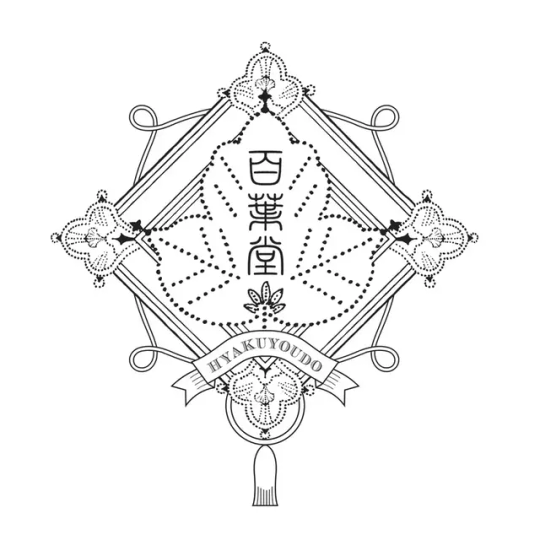
The origin of the name "Hyakuyoudo"
Interviewer: How many staff members are there?
Anno: We've increased to about 7-8 people since this year. Packing and shipping kimonos requires professional skills. If you just fold them and send them off, they'll shift around and get wrinkled inside, so you need to wrap the kimono in wrapping paper and insert paper to prevent it from shifting. That kind of work requires training. Also, it's difficult for amateurs to check for needles left in the kimonos after sewing. You often find a paper that says "Checked for needles" included when you buy a kimono, but you need someone to do that.
Interviewer: So, you need professionals just for shipping and inspection.
Anno: Yes. And at sales events, you need people who can dress customers and take measurements. We've started holding fitting events twice a year, and even then, you need someone who can wrap fabric like a kimono.
Interviewer: Ah, it's the process of fitting the fabric to the customer's body.
Anno: That's right. Customers can imagine themselves wearing it. Including the people who participate in the fitting events every time and those who always participate in regional events, there are quite a few.
Interviewer: And you're controlling all of that as the president?
Anno: No way, I couldn't do that. The dressing instructor supports the operation, so I just draw the patterns. The instructor arranges them properly as kimonos and places orders with digital printing companies.
Interviewer: Is it like necessary people naturally gather?
Anno: That might be true. When we suddenly got a request for an event at Isetan, someone who had been a store manager at a certain kimono shop for many years suddenly came to us saying they wanted to work at Hyakuyoudo, even though we weren't recruiting. It was incredibly lucky.
Interviewer: They're very persistent.
Anno: I still tell everyone that if S-san hadn't joined us then, we would have been crying at Isetan, clueless about everything like the setup. We didn't even know the rules for setting up displays at pop-up stores, and we somehow managed to make it work thanks to her joining us at the last minute. She kept bringing in salespeople who could dress customers. So, without the dressing instructor who supports the printing operation and her who supports the sales operation, Hyakuyoudo wouldn't exist.
Interviewer: Is the name Hyakuyoudo derived from your name, Moyoco-san?
Anno: Yes. And I hope to have about 100 patterns eventually (laughs). Initially, we only had about two, so I thought it would be nice to have about 100 base patterns.
Interviewer: Are all those 100 patterns drawn by you, Momoko?
Anno: Yes.
Sketches to elevate to the patterns I desire
Interviewer: So, have you been using the patterns of those kimonos for the cover of "Netsufū" all along?
Anno: No, there are plenty of different things. The patterns that look good in illustrations and the patterns that make lovely designs on actual kimonos are quite different.
Interviewer: Does studying dressing and patterns deeply affect the way you draw kimonos?
Anno: Yes, it does. The way people wear kimonos varies depending on their age and other factors. In the February issue's cover, there's a girl kneeling down, but that's actually because her foot has fallen asleep. Her foot is asleep, and she's trying her best to stretch it out by squeezing her thumb tightly.
Interviewer: I thought it was a beautiful illustration, but I didn't realize her foot was asleep (laughs).
Anno: Her foot is asleep. This girl doesn't really unbutton her collar that much. Also, she's pulling her neck quite tightly. But for older people or in the summertime, it's more stylish to have the collar a bit unbuttoned, or it gives a more realistic feeling of wearing it.

Interviewer: Drawing the ideas for each illustration, how do you usually come up with them? For example, the February issue features peaches.
Anno: Yes. I usually try to draw images of the upcoming season. So, for example, I thought about cherries for April, but it's better to capture a slightly earlier season.
Interviewer: I've heard that you struggled when you first started drawing patterns. What was difficult about it?
Anno: Making patterns is difficult. There are many people who can draw plants very well, but even if you draw plum blossoms realistically, they won't become a kimono pattern. Or even if you draw them in a manga-like style, at least I don't want such a kimono. It's very difficult to take it to the point where it becomes a pattern that I would want.
Interviewer: But Moyoco-san is essentially a professional artist. Is it still difficult for such a professional to imagine?
Anno: It doesn't work out. There are many things I started but then gave up on. I was really enthusiastic about making a kimono belt with cherry blossoms and night cherry blossoms this year, but I couldn't make it at all.
Interviewer: Could you explain a bit more about why it's so difficult?
Anno: It takes time, for one thing. There are already many different kinds of plant patterns, from abstract designs to patterns close to sketches, that have existed as antiques for a long time. But just copying those isn't enough. It's better to have existing patterns. At first, I thought that maybe if I copied existing patterns extensively and incorporated them into my imagination, reconstructing them, it might work. But no matter how much I did it, it didn't work. I wondered why it didn't work, but the fact is, if it's plum blossoms, you have to sketch them to death to make it work.
Interviewer: You have to confront the real thing until the plum or cherry blossoms are abstracted in your mind.
Anno: That's right. And then it takes quite a bit of horsepower to take it to the level of cuteness as a pattern. There's a pattern called "Mimosa" that I made this spring, and I got a lot of them from my friends.
Interviewer: It's your favorite flower, isn't it?
Anno: Yes. I received a lot of them last year and this year, and I was really moved, so I sketched them every day. As I drew a lot, I gradually understood the characteristics, and then I could draw the pattern without making it look exactly like the real thing. What I found cute about the mimosa was the cute overlapping leaves, and I started depicting them in the pattern. When you see the beauty of the maple leaves falling to the ground and the shadows of the maple leaves on the ground, you understand what people in the past thought about, and that helps with the pattern.
Interviewer: So you've transitioned from the step of copying to a more fundamental step.
Anno: That's right. But I still think I'm in the early stages of development. I've just realized that, and if you ask if I've succeeded, I haven't succeeded at all yet. It's just that I've finally realized that much.
Interviewer: You seem to really like plants.
Anno: Yes, but I also want to draw birds. The good thing about old Japan is that people loved nature so much, and there are kimono patterns with ears of rice that are only in season for about two weeks. Of course, I think only rich young ladies wear them, but I want people to wear them more casually. "Hyakuyoudo" also sells obi belts, and for example, with a reversible obi belt, you can use it for two different seasons, such as using tulip patterns for two weeks and then switching to chrysanthemum patterns.
Interviewer: Japanese people used to love nature so much. You want to incorporate that into your patterns.
Anno: Yes, I enjoy doing that kind of work. It's really nice nature… I also love daffodils, so I released a daffodil obi belt for this winter, but I thought it might be a little too much like a drawing of daffodils.
Interviewer: Oh, really (laughs).
Anno: While I was doing it, I thought it might be a little different, but it turned out cute, so I released it, thinking that someone might want it. Well, I still plan to draw various daffodils.
Interviewer: Do you observe landscapes and plants in your daily life?
Anno: I've always loved flowers, and the flowers I receive from the florist every week, I draw them every morning. I can't do it when I'm chasing manga deadlines, but I try to draw them every morning when I have time.
Interviewer: Is that for the kimono patterns?
Anno: Yes, it is. Once I draw them.
Interviewer: Do they make it into your drawings?
Anno: They do. They really do. So I try to draw them at least once during the season. I don't know if the leaves grow on the left and right together or alternately. But once I draw them properly…
Interviewer: You incorporate their presence into yourself.
Anno: That's right. You have to do it. Just looking at them doesn't cut it.
Interviewer: Do you ever look at botanical encyclopedias? Like the paintings by Tōtaro Makino from NHK's morning drama.
Anno: Yes, I do. Artists like Hisui Sugiura. His works were stored in a museum in Shibuya Ward, so I used to stop by and see them on my walks. There's an exhibition in Takasaki this spring, so I plan to go and see it. It's a good study to see where predecessors with excellent painting skills and artistic sense choose to focus. Like, which part of this flower, stem, or joint do they choose to depict? You start to understand what they like, such as liking stems. The kind of picture I want to turn into a pattern for the back of an obi belt isn't just a picture of the plant itself; it's like the base of a lily bud depicted as slightly plump. That's the kind of picture I want to carry on my back.
Interviewer: I see. So it's better when the fetish of the person who drew it is incorporated, isn't it?
Anno: That's right. It's definitely interesting when the feelings of the pattern designer are reflected.
Director Anno and Kimono
Interviewer: Do you ever go to the mountains to sketch plants?
Anno: Surprisingly, wildflowers that grow deep in the mountains aren't really suitable for kimono designs (laughs). They're unfamiliar, you know? If I were to use them as patterns, it might be better to focus on areas with lower elevations. Although the Kusamaki (Japanese shrub) is beautiful, the trees are too big and too far away to see clearly. So, I often use flowers sent from florists as my subjects. I've told them before that I always want something I can use as my motif. So, this year, I've been asking them to send me lots of plums. They've been sending them to me every week.
Interviewer: Do you have any flowers you always want to draw?
Anno: Yes, there are. It's quite a mysterious coincidence. The florist I mentioned is actually the daughter of a kimono shop owner. Although her family's shop has already closed down, since she grew up surrounded by kimonos, she knows what kind of plants would be suitable for kimono designs and sends them to me accordingly.
Interviewer: That's quite a fortunate coincidence.
Anno: Yes, it really is.
Interviewer: Now, in terms of the balance between your work on manga and creating kimono designs, how does that ratio look?
Anno: Well, one thing I've decided on is not to push myself too hard with kimono designs if they interfere with my manga work. Manga is my main job, so I don't want to struggle too much with patterns. The basic idea is always to create patterns that I and the people around me who love kimonos would want, so I always keep that in mind.
Interviewer: Among the cover illustrations you've done over the past two years, there are three instances where you depicted men wearing kimonos. Was there a particular reason for that?
Anno: It's because I feel men should wear kimonos more.
Interviewer: Including Director Hideaki Anno?
Anno: He doesn't wear them. I've tried to get him to wear one by buying things like Ultraman yukatas (light cotton kimono worn in summer) (laughs), but he never wears them.
Interviewer: It seems like it would suit him.
Anno: It doesn't. His legs are too long, so the position of the obi ends up being too high, making him look like a fool (laughs). He also tends to walk with his weight forward, walking all floaty like that. So, he ends up looking like Ganmo (a comic character drawn by Fujio Akatsuka).
Interviewer: Does Hyakuyoudo have men's kimono?
Anno: We've received several requests from men, but we still have few patterns specifically for men.
Interviewer: Nevertheless, designing kimono with polyester material is quite an innovative idea.
Anno: Yes, indeed. Considering the idea of making it easy for people to wear them regularly, it was important that they could be easily washed. When you send a regular kimono to the cleaners, it costs as much as buying a new one. Hemp juban (undergarment worn beneath a kimono) can be washed in a washing machine, which is great, but we're still in the prototype stage. The black ground with the Yukiwa pattern makes it suitable even for men.
Interviewer: Do you have any new ideas for the third year's cover starting soon?
Anno: I'm thinking of making it a bit more like ukiyo-e (Japanese woodblock prints) in style. Not just the design but also adding elements like the artist's signature, explanatory frames, and titles commonly seen in ukiyo-e. I'm considering making it a bit more decorative.
Interviewer: Speaking of ukiyo-e, you recently tweeted about visiting the Ota Memorial Museum of Art in Harajuku, Tokyo, and how deeply moved you were by the "Hiroshige Ojisan Zufu" (Illustrated Book of Mr. Hiroshige).
Anno: It was so much fun. In the landscape paintings by Utagawa Hiroshige, there are lots of tiny old men depicted, and when you look closely at their faces, each one has a different, expressive face, and they're all so cute. None of them have the same face. Some are walking alone, smiling, others look cold, some are happily eating lunch, and others are filled with relief upon finally reaching the inn.
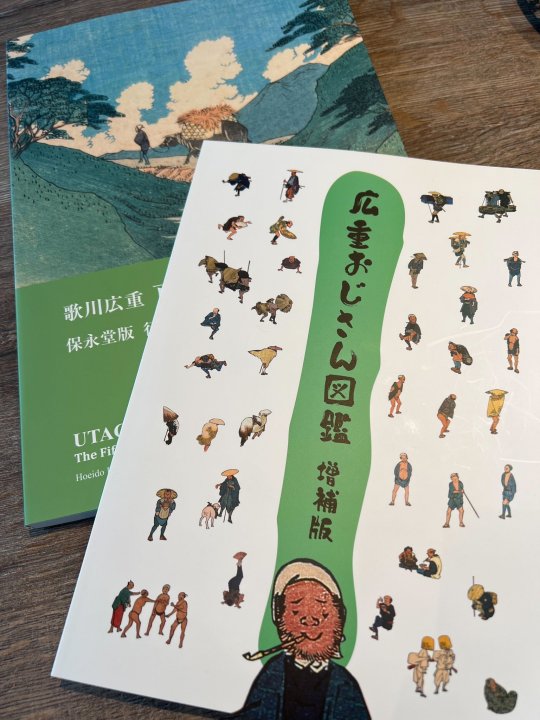
Interviewer: You paid a lot of attention to the details.
Anno: Yes, the expressions of those who arrived at the inn are great. Although they are just extras in the big picture, the personalities of each of those extras are meticulously depicted. Along the Kiso highway, there are three somewhat suspicious-looking characters, sticking out their bellies or warming their backsides by the fire. Those three definitely seem like they could be horse thieves or something. At first glance, because the landscapes are the main focus of the painting, you wouldn't notice them unless you looked closely.
Interviewer: Indeed, you really have to pay close attention to notice.
Anno: Exactly. But when you look closely, it's amazing, isn't it? Apparently, it was first noticed by the curators of a local art museum, and they proposed the exhibition. I admire how they found it. Hiroshige would probably be happy to know that his work was noticed.
Interviewer: That's wonderful. We're looking forward to your ukiyo-e style cover illustrations, Moyoco-san.
Anno: Yes, I'll do my best! (laughs)
(This interview was conducted on April 10th.)
◇ Composition by Taku Yamashita.
First published: "Neppū" June 2023 issue (published by Studio Ghibli)
The Instagram account for Moyoco Anno's kimono brand "Hyakuyoudo" is regularly updated with the latest information.
Sources:
https://note.com/anno_moyoco/n/n611652bab695
https://www.hyakuyoudo.com/
https://www.instagram.com/hyakuyoudo/?hl=es
https://twitter.com/anno_moyoco
https://twitter.com/anno_moyoco/status/1757691347098911015?s=20
#moyoco anno#anime#manga#shojo#josei#shojo manga#josei manga#shojosei#sugar sugar rune#kimono#design#art
28 notes
·
View notes
Text
hello, first post!
i’m anais (real name)!! or annie :D

she/her ☆ infp 4w5 469 ☆ half white, half 🇨🇳🇵🇦!! ENG | 中文 ☆ late teens ☆ formerly @dearest-dada ☆ carrd
While I’d love to start an art history side blog, this is just my little corner of the internet for now.
I like a lot of things:

★ authors. . . katherine mansfield, franz kafka, françoise sagan, virginia woolf
★ shows. . . ghosts ✨, portrait of a marriage, HATARAKI MAN!!!
★ movies. . . j. edgar, battle of the sexes, gilda, paperman,
★ music. . . mainly riot grrl and j-pop also old music
★ hobbies. . . playing tennis, drawing, going on wikipedia, staying up reallyyy late.
#golden-age hollywood#tennis#classic literature#classical music#drawing#ghosts#looking for moots#short films#art history#françoise sagan#bbc tv#franz kafka#katherine mansfield#virginia woolf
6 notes
·
View notes
Text
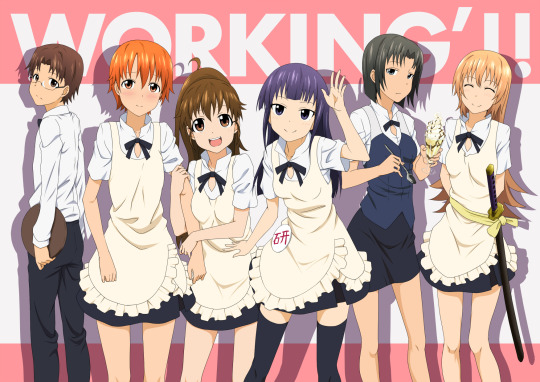
Anime Job Fair! - Workplace Anime Masterlist
I've decided to curate a list of anime that take place in real-life fields of work. Fictional jobs have been excluded. Also excluded are idols and professional athletes because there's about a zillion of those. Please suggest more and I'll keep adding to this!
Agriculture
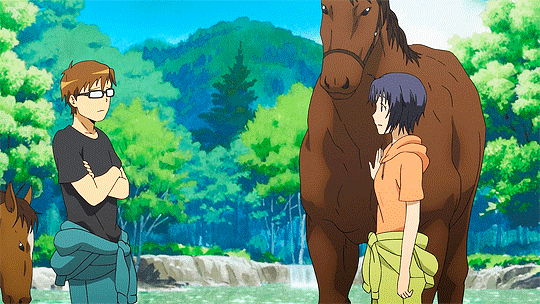
Moyashimon (Microbes/fermentation)
Silver Spoon (Animal husbandry)
Anime Production Employee

Girlish Number (Voice acting)
Shirobako
Sore ga Seiyuu! (Voice acting)
Aquarium Employee
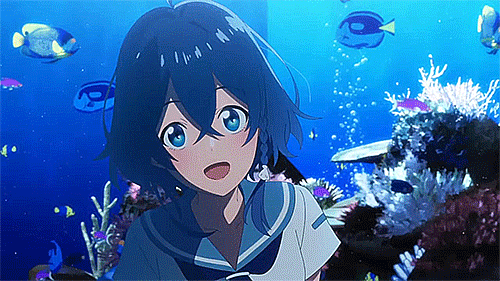
The Aquatope on White Sand
Astronaut
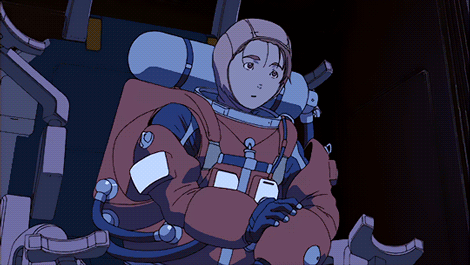
Planetes
Uchuu Kyoudai
Civil Servant
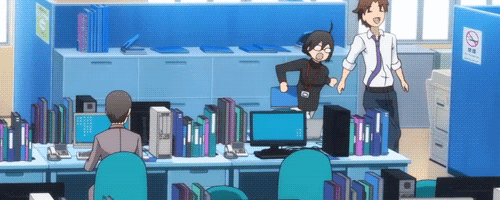
Servant x Service
Food Service Employee
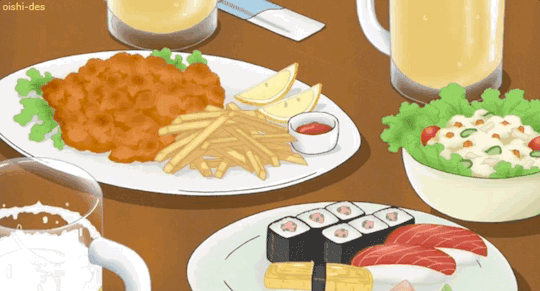
Ame-iro Coca (Cafe)
Antique Bakery (Bakery)
Bartender (Bar)
Blend S (Cafe)
Deaimon (Sweet shop)
The Devil is a Part-Timer (Fast food)
Is the Order a Rabbit? (Cafe)
Isekai Izakaya: Japanese Food From Another World (Izakaya)
Neko Ramen (Ramen shop)
Piacevole: My Italian Cooking (Restaurant)
Polar Bear Cafe (Cafe)
Ramen Fighter Miki (Ramen shop)
Restaurant to Another World (Restaurant)
Ristorante Paradiso (Restaurant)
Working!! (Family restaurant)
Yotsuiro Biyori (Cafe)
Game Developer

Koe de Oshigoto! (Eroge voice acting)
New Game!
Hospitality
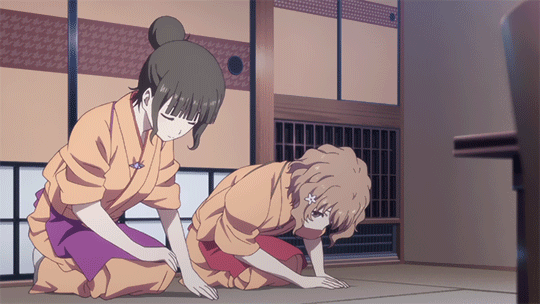
Amagi Brilliant Park (Amusement park)
Hanasaku Iroha (Inn)
Kiyo in Kyoto: From the Maiko House (Maiko)
Konohana Kitan (Inn)
Sparrow's Hotel (Hotel)
Jeweler

The Case Files of Jeweler Richard
Lawyer

Ace Attorney
Librarian
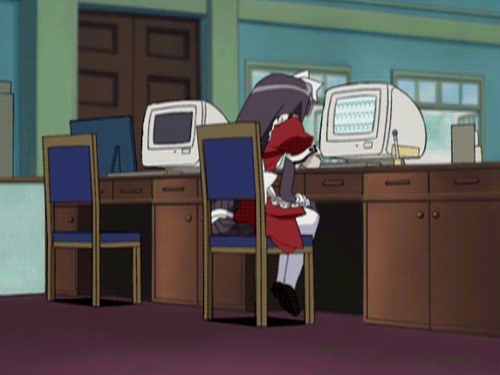
Kokoro Toshokan
Medicine

Monster Girl Doctor
Parallel World Pharmacy (Pharmacology)
Ten Count (Psychotherapy)
Welcome to Irabu's Office (Psychotherapy)
Military
Yomigaeru Sora: Rescue Wings (Fighter pilot)
Police

Police in a Pod
You're Under Arrest
Publishing
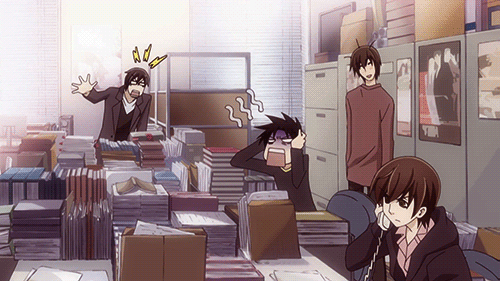
The Great Passage
Hataraki Man (Magazine company)
Mangirl! (Manga magazine)
Sekaiichi Hatsukoi (Editor)
Radio
Android Announcer Maico 2010
Retail Worker
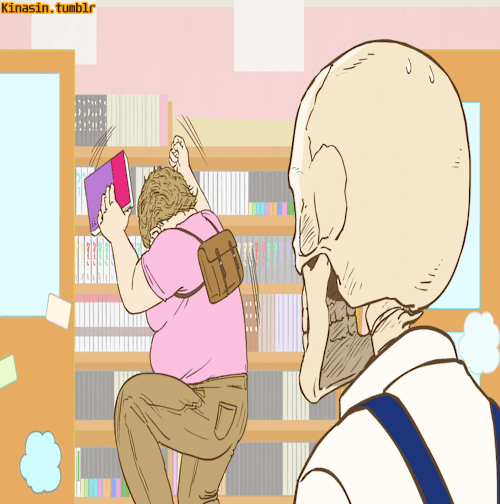
Holmes of Kyoto (Antique store)
Denki-gai (Bookstore)
Skull-face Bookseller Honda-san (Bookstore)
That is the Bottleneck (Convenience store)
Teacher

Gokusen (Math)
GTO (Great Teacher Onizuka) (Social studies)
Hanamaru Kindergarten (Kindergarten)
Ultimate Otaku Teacher (Physics)
Television/Film
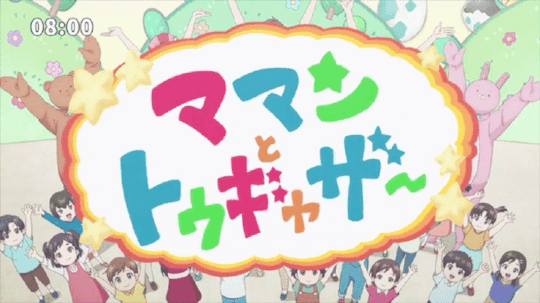
ABCiee Working Diary (TV production)
Pompo the Cinephile (Film production)
Uramichi Oniisan (Performer)
World Fool News (News anchor)
Transportation
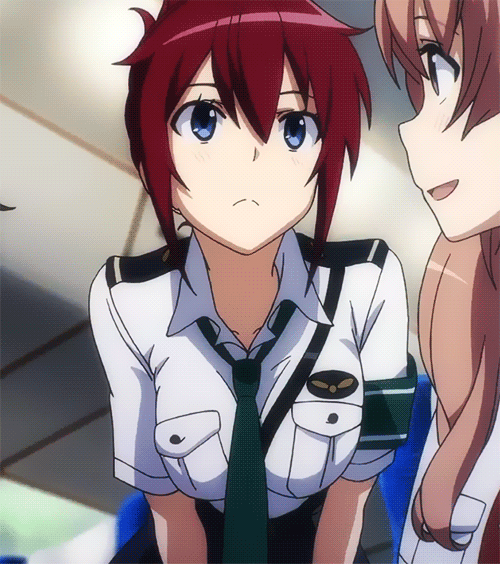
Aria (Gondolier)
Rail Wars! (Railroad workers)
#honestly haven't seen most of these#anime#I'm watching servant x service so that was my inspiration
24 notes
·
View notes
Text
JVC Post #12
˚୨୧⋆ ˚。⋆ Rose of Versailles ⋆ ˚。⋆୨୧˚
I'm so excited for this week! I love shoujo manga/anime, and Rose of Versailles is no exception.

The difference in style and content is immediately clear when reading this manga, at least compared to what we've read and watched up until this point. The frills and ribbons, the historical western setting, the playing into fantasies of princes and princesses, the sparkles and flowers adorning each page; All of these little bits and pieces come together to form the shoujo style.
Rose of Versailles in particular is part of a lineage of bejeweled, fancy stories of historical love and romance, and was arguably the first huge hit for the developing shoujo genre. It's really cool honestly, as it was also one of the first big hit manga written by a woman, it features an androgynous cross-dressing character in Lady Oscar, and would go on to be hugely influential on later work in the genre.
Many other golden age shoujo manga like The Poem of Wind and Trees and Glass Mask involve some combination of these traits, frequently taking queues from their contemporaries, but Rose of Versailles is probably the most important out of all of them. This movement of shoujo was spearheaded by a group of women called the Year 24 group. They published lots of great work if you wanna read.
You'll notice as well that the frame-structure of shoujo manga is also much looser and more free-form compared to other styles of manga. Characters and subjects often cover large regions of the page and burst through the frames.

This technique was sort of a staple of the style at the time as far as I can tell, and Rose of Versailles was one of the frontrunners of filling pages with loosely confined, decadent, sequined visuals. It's something that I think really defines the entire visual style of the genre.
I also love the characterization of Lady Oscar in the story. She's a truly complex character, not half-baked or one-dimensional. She's a great example of the way that gender is often played with in shoujo manga too (which is in large part because of her success as a character). I also love that she's not "just" a tomboy. Her masculinity is genuinely a very important part of her character, and her womanhood is never portrayed as a weakness.
It's one of my favorites so I hope you enjoyed it. If you want to check out more shoujo I highly recommend:
Anything popular from CLAMP (Cardcaptor Sakura, Magic Knights Rayearth)
Ai Yazawa's shoujo stuff (NANA)
Futari wa Pretty Cure
Fruits Basket
Kodomo no Omocha
KareKano
Revolutionary Girl Utena
And I'm going to take this opportunity to shill Kyoko Okazaki and Anno Moyoco even though they write josei manga with more mature themes.
Kyoko Okazaki (Helter Skelter, River's Edge, Pink)
Anno Moyoco (In Clothes Called Fat, Happy Mania, Hataraki Man)
2 notes
·
View notes
Note
in need of some good manga recommendations! what are your faves?
please love the useless me, hataraki man, hirayasumi, kamisama kiss, march comes in like a lion, rapid commuter underground, urusei yatsura, yugami has no friends, ashi-girl, cats of the louvre, sunny, darling wa namamono ni tsuki, shinobi life, space ship ee, when a cat faces west, blissful land, lovesick ellie, mob psycho, slam dunk, wandering island, gokusen &c &c
1 note
·
View note
Text

Il manga Hataraki Man di Moyocco Anno avrà un nuovo volume dopo 17 anni Il manga è stato lanciato nel novembre 2004 sulla rivista Morning di Kōdansha ed è in pausa dal 2008. Info:--> https://www.gonagaiworld.com/il-manga-hataraki-man-di-moyocco-anno-avra-un-nuovo-volume-dopo-17-anni/?feed_id=455008&_unique_id=666be39d52d39 #HatarakiMan #Manga #MoyocoAnno
0 notes
Text

hataraki man - moyoco anno (2004-2006)
11 notes
·
View notes
Text
0 notes
Text
Hataraki Man
Hiroko Matsukata is a woman who works for a magazine company. She puts all she has into her work, and is known as a strong, straight-forward working girl, who can at will turn herself into Hataraki man (working man) mode. Despite Hiroko's success at work, her life lacks romance. Even though a hard worker, she'd leave early anytime to go on a date. Too bad her boyfriend is even bigger a workaholic than Hiroko.

0 notes